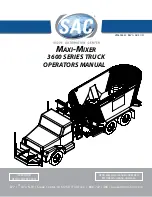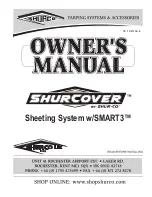
94
In so doing outlet valve 20 is closed, and inlet valve 21 is opened, and the
compressed air flows from outlet I to outlet II and further to the trailer connecting
main. When the pressure in outlet II reaches a certain value set with the help of
adjusting screw 24, piston 4 overcomes the force of spring 23 and lowers down; as a
consequence of it inlet valve 21 sits down onto the saddle in piston 4. Thus, in the
released position of the trailer main the pressure, which is less than that in the
towing truck pneumatic drive, is maintained automatically.
When braking the towing truck, the compressed air is delivered to outlet IV
and fills in under-diaphragm hollow B. Overcoming the force of spring 14, dia-
phragm 16 goes up with pusher 19. Inlet valve 21 closes, then outlet valve 20 opens
the air from the trailer connecting main flows out to the atmosphere via outlet II,
pusher19 and outlet III in cover 12 until the pressure in hollow B under diaphragm
16 and that in hollow 7 under stepped piston 8 is balanced by the pressure in the
hollow above the stepped piston.
When further reduction of the pressure at outlet II occurs, piston 8 lowers
down and moves down pusher 19, which closes outlet valve 20, as a consequence of
it the air flowing out from outlet II is stopped. Thus, the follower action is per-
formed.
The trailer (semi-trailer) is braked with the efficiency in proportion to the
value of the compressed air supplied to outlet IV. Further pressure growing at outlet
IV results in the complete evacuation of the compressed air from outlet II and by so
doing – in the most efficient trailer braking. When releasing the trailer brake, i.e.
when the pressure drops at outlet IV and in hollow B under diaphragm 16, the latter
under the action of spring 14 returns to its initial position. Pusher 19 lowers down
with the diaphragm. In so doing outlet valve 20 closes and inlet valve 21 opens. The
compressed air from outlet I flows to outlet II and then to the trailer connecting
main and as a consequence of it the trailer (semi-trailer) brake is released.
The control valve of the trailer brakes
with the double-line drive
is shown in
Fig.75. The air is continuously supplied to outlets II and V of the control valve; the
air, acting on diaphragm 11 from the top and on medium piston 10 from the bottom,
holds rod 12 in the lower position. In so doing outlet IV connects the trailer brake
control main with atmosphere outlet VI through the central hole of valve 3 and
piston 12.
The trailer is braked, when the air is delivered through outlet IV into the trailer
main, when the air is supplied to outlets I and III as well as when the pressure drops
at outlet II (the truck braking with the help of the parking brake).
When delivering the air to outlet III, pistons 4 and 7 move downwards, inlet
valve 3 opens, and the air from the bottle through outlet V, opened inlet valve 3 is
supplied to outlet IV, which is connected to the trailer control main with the help of
coupling head 16 (see Fig. 67) as well as the air is simultaneously flows to the con-
trol valve of the trailer brakes with a single
-
line drive.
The action of the follower begins, when the forces acting on piston 7 (see
Fig.75) from below and above are balanced. Under this condition the pressure of the
air, flowing to outlet IV, is proportional to the pressure of the air, flowing to outlet
III.
When the braking is stopped, the air is run out of outlet III to the atmosphere
through the brake valve. Pistons 4 and 7 are returned back to their initial position
(by spring 8 and air pressure at outlet IV), intake valve 3 gets closed. That moment
outlet IV is in communication with the atmosphere through the hole in valve 3,
piston 12 and outlet VI.
Содержание 4320-10
Страница 1: ...URAL 4320 10 URAL 4320 31 TRUCKS AND THEIR MODIFICATIONS ...
Страница 180: ...179 Fig 119 Truck Lubrication Diagram ...





































